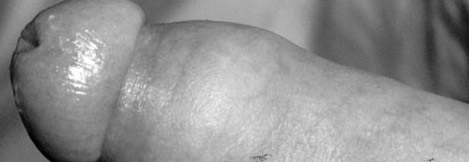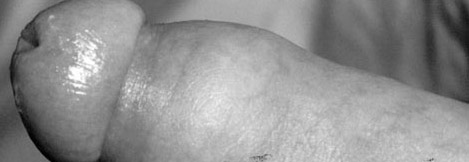"Because the foreskin is a mistake of nature..."
- Dr Thomas Wiswell

Phimosis on the adult male penis, where the foreskin is too tight to fully retract over the glans.
The variety of reasons given for male genital circumcision (and the irrationality of many of them) is simply amazing. According to ancient Egyptian beliefs, circumcision would make a man immortal, like a snake gaining a new life when it sheds its skin. Similarly, the Xhosas believe that circumcision enables a man to communicate with the spirits of his ancestors and would prove most effective in warding off evil. Other quack medical arguments against the retention of the foreskin would include masturbatory insanity, hysteria and even nocturnal incontinence.
Today, the oft-cited reasons for circumcision are religious, cultural or medical (i.e. a condition known as phimosis where the foreskin is uncomfortably tight and difficult to retract). Sex appeal is another common reason offered by most - with the exception of hardcore paedophiles or those with a foreskin fetish - who prefer the circumcised penis because it "looks sexier, stayed cleaner and felt better". Cleanliness and proper hygiene are two other arguments branded about most frequently to justify why circumcision is a necessary evil.
In an important survey conducted by researchers from Australia, it was found that circumcised men are two to eight times less likely than uncircumcised men to become infected with HIV. The survey draws its conclusion from the fact that the inner surface of the foreskin is rich in Langerhans' cells (the penis' primary point of viral entry) and the presence of these cells increase the risk for HIV transmission. A recent New England Journal of Medicine editorial likewise stated that the spread of HIV appeared less rapid in those Asian countries where circumcision is routine (e.g. the Philippines, Indonesia and Bangladesh).
Anti-circumcision activists, however, are opposed to the procedures, arguing that circumcision is medically unnecessary and, in the case of newborns, an outright case of mutilation. Pain, of course, is another valid concern. While true adepts generally perform the procedure in less than two minutes, the operation is still painful. Furthermore, all surgeries, however safe, carry risks of bleeding, infection or even an adverse reaction to anesthesia. Other long-term after-effects include skin tags, prominent scars, tight erections, bleeding during sex, curvature of the penis and sexual dysfunction.
Perhaps the most persuasive argument revolves around the loss of sexual pleasure. The foreskin is after-all the most erogenous tissue of the penis, containing over 240 feet of nerves and over 1,000 nerve endings. The removal of the foreskin would hence make quite a substantial dent in one's sex life, especially so when the healing process involves complete abstinence from vigorous exercise and yes, sex.
While circumcision remains a contentious one, what is "clear-cut" (pardon the pun) about the issue is that once you get circumcised, there's no good way to undo the procedure. Unlike circumcision, foreskin restoration is purely a cosmetic process and should be performed by a qualified urologist.

Phimosis on the adult male penis, where the foreskin is too tight to fully retract over the glans.
The most successful method currently practiced by surgeons is skin grafting. In this process, the surgeon makes a cut around your penis, lifts the skin off your shaft and pulls it down over your glans. The resulting patch of exposed penis (near the pubic hair) would be covered over by skin taken from another part of the body.
Having said that, foreskin restoration surgery, like all surgery, is a complicated process and could produce severe scarring (in addition to a hefty medical bill). Likewise, many men are under the false impression that foreskin restoration would lead to an increase in sensation during intercourse. The truth is, once circumcision occurs, the skin toughens and it will never return to its previous soft texture. And if you long to possess a penis that resembles those uncut tools you fantasize over, wake up - the end-product will probably come up short (pardon the pun again).
So unless it is medically necessary for you to go under the knife, don't ever get pressured into getting circumcised unless you really want it. Likewise, if you are already circumcised, don't jump onto the bandwagon to have your foreskin restored. Think through the process and reasons thoroughly and then make an informed decision.
Remember, it's your body and your penis.
And it's definitely your choice.
Quote: "For thousands of years, in many different cultures, the genitals have fallen victim to an amazing variety of mutilations and restrictions. For organs that are capable of giving us an immense amount of pleasure, they have been given an inordinate amount of pain".
- Desmond Morris











 Printable Version
Printable Version











